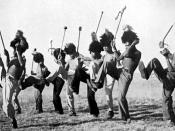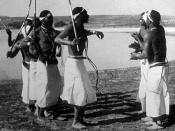Since the world of technology emerged, the appealing characteristic of an entity that was natural has held the curiosity of men. The "Gestures of Self-Protection," submerges into this fascination with something natural that is unaffected by technology and "new world" views. Ethnography tries to capture the essence of what was. "Gesture of Self Protection" examined salvage ethnography, which is the idea of reconstruction of something natural. The urgency of this kind of work comes from the idea that certain cultures are quickly going to be distinct. Even though these cultures are celebrated as the past of human existence, the emphasis is not placed on the survival of the people, but it is placed on the collection of data. Many of the films produced in the early 1900s tried of convey images of "primitive races" in their natural habitat, but the actual input of the producers were never visible in their films; consequently, the authenticity of the films were affected.
"The Negro Dance: Under European Eyes" was an article exploring the comparable differences of African and European dancing. André Levinson tried to explain the dance of African with his own beliefs intact. In the beginning of the article, the fascination of Black dance in the 1920s was labeled as an "inspiration to French artist." A large number of African American artists relocated to Europe to better express their talents and live in a community more receptive to them as people of color. Levinson wanted to find and recognize the uniqueness of African dance. He established the idea that African dance was innate, and something that all Africans encompass. Even though he detailed an unique characteristic of Africans, he believed the dance form was free of intellectual theory; therefore, it was inferior to it's European counterpart. On page 83 of the...


